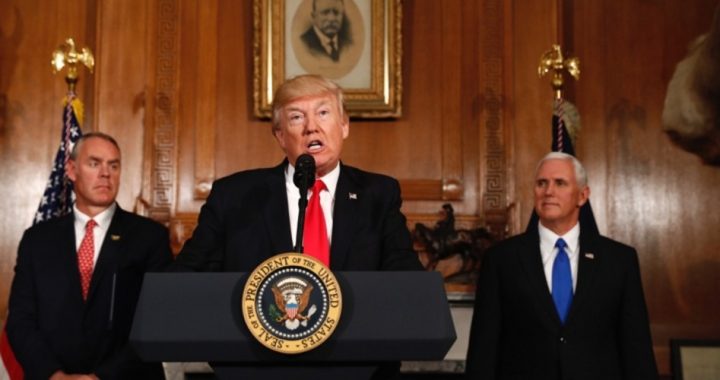
In the wake of an administration that seized control of record amounts of land and water, President Donald Trump on Wednesday issued an executive order that he said would “end” such “abuses” of federal law and “return control to the people.”
The order requires the Secretary of the Interior, Ryan Zinke, to review all federal monument designations of more than 100,000 acres made under the 1906 Antiquities Act since 1996. That year, President Bill Clinton created the Grand Staircase-Escalante National Monument; covering nearly 1.9 million acres of southern Utah, it is the largest monument designated to date. President Barack Obama commandeered another 1.3 million acres of the Beehive State in late December to create the Bears Ears National Monument over the objections of state lawmakers and Utah’s congressional delegation.
Obama went on a real-estate seizure spree during his eight years in office, grabbing more than 553 million acres of land and water under various federal laws. According to Trump’s remarks at the signing of his executive order, his predecessor used the Antiquities Act to set aside “over 265 million acres,” which the president noted is “larger than the entire state of Texas.” Obama invoked the act 29 times, about one-fifth of all the times it has been used, usually to reward supporters and push his agenda of combating alleged climate change by putting land off-limits to mining, logging, and energy exploration.
“The Antiquities Act does not give the federal government unlimited power to lock up millions of acres of land and water,” said Trump, “and it’s time we ended this abusive practice.”
Zinke must produce an interim report on monuments including Bears Ears within 45 days and a final report within 120 days, Trump’s order states. Those reports are to “include recommendations for such presidential actions, legislative proposals, or other actions consistent with law as the secretary may consider appropriate.”
Presidential actions may include reducing the size of existing monuments in keeping with the Antiquities Act’s language requiring them not to exceed “the smallest area compatible with the proper care and management of the objects to be protected.” Presidents have the power to increase the size of monuments; Obama, for example, quadrupled the size of the Papahānaumokuākea Marine National Monument off the coast of Hawaii, creating the world’s largest marine reserve and harming the local fishing industry. They can also shrink monuments; President Dwight Eisenhower cut the size of Colorado’s Great Sand Dunes National Monument by a fourth.
On the other hand, it is unclear whether a president can fully revoke a monument designation. According to a 2000 Congressional Research Service report:
At first glance, it would appear that this question should be answered in the affirmative since Presidents certainly have modified or revoked executive orders, and at times executive orders and proclamations have been used interchangeably to carry out land actions. But some see the proclaiming of a national monument as a special category of action that may not simply be undone….
An attorney general’s opinion [from 1938] concluded that a President could validly modify a monument…. However, the Opinion also concluded that a President could not eliminate or terminate a monument established by previous Presidential action. The Opinion noted that there was no separate statutory authority for the President to revoke or terminate a monument, and therefore any authority that existed for this purpose must be implied by the other powers given the President in the Antiquities Act. The Opinion then reasoned that because the President had no inherent authority over lands, the President was acting only with authority delegated to him by Congress; a monument reservation was therefore equivalent to an act of Congress itself; and the President was without power to revoke or rescind a monument reservation.
Since no president has ever attempted to revoke a designation, no one knows how the courts might rule if such an action were challenged. “Environmental groups and tribal officials say they stand ready to sue over any attempts by Trump to change the footprint or eliminate designations of existing monuments,” reported Politico.
Environmental groups are, naturally, up in arms that Trump might dare to return some land to productive use. Jennifer Rokala, executive director of the Colorado-based Center for Western Priorities, told Politico, “This administration has made it clear that they’re going to do the bidding of the oil and gas industry.”
No one — least of all the energy industry — is pretending that opening up federal land to oil and gas exploration isn’t on the radar.
“There’s absolutely interest in developing oil and natural gas resources on public lands,” Erik Milito, director of upstream and industry operations at the American Petroleum Institute, told Politico. “There’s highly prospective areas for the industry and we’ve seen considerable development on state and private lands in the vicinity of public lands, which would demonstrate that there could be far greater opportunities if we had a more streamlined process and more opportunities by eliminating these types of obstacles to development.”
One might reasonably ask why companies shouldn’t be allowed to search for domestic energy sources on land they are paying taxes to maintain. But then who ever said radical environmentalists, who view mankind as a plague on Mother Earth, were reasonable?
Energy companies aren’t the only ones pleased with Trump’s order. Congressional Republicans are hoping at least some of the land Obama confiscated will be released, particularly since it was often taken despite opposition from state and local officials.
“We’re happy to see an administration finally taking action to resolve the many abuses of the Antiquities Act,” a spokeswoman for Representative Rob Bishop (R-Utah), chairman of the House Committee on Natural Resources, told the Daily Caller.
Pointing particularly to Bears Ears and another Obama designation, Maine’s Katahdin Woods and Waters National Monument, “Bishop said the Obama administration ignored local concerns about land use and economic activity — ranching, logging, drilling and mining, for example — in communities surrounding monuments,” wrote the website.
Senator Orrin Hatch (R-Utah), who tweeted that Obama’s use of the Antiquities Act was “exec[utive] overreach at its worst,” deserves much of the credit for prompting Trump’s order, as even the president himself admitted at the signing ceremony. Hatch has good reason for wanting to reverse federal land grabs: Uncle Sam owns 63 percent of the land in Utah.
Trump, Hatch said, is “committed to rolling back the egregious abuse of the Antiquities Act to serve far-left special interests.”
In that case, why not go whole hog and try to convince Congress, which is controlled by Republicans, to repeal the 111-year-old law? It locks up land that could be used productively, it tramples on states’ rights, and — most importantly — it’s unconstitutional. Repeal may prove to be a monumental task, but it’s the only way to guarantee that future presidents won’t undo whatever good Trump manages to accomplish with this order.
Photo of President Trump with Interior Secretary Ryan Zinke (left) and Vice President Mike Pence at the Interior Department: AP Images



